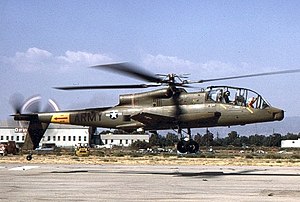Lockheed AH-56
| Lockheed AH-56 Cheyenne | |
|---|---|
 AH-56 at take-off - with all three rotors in action |
|
| Type: | Experimental combat aircraft |
| Design country: | |
| Manufacturer: | |
| First flight: |
September 21, 1967 |
| Commissioning: |
not put into service |
| Production time: |
Pre-series 1967 to 1969 |
| Number of pieces: |
10 |
The Lockheed AH-56 Cheyenne was an experimental attack helicopter and flight helicopter of the United States Army .
history
It was developed in the mid-1960s in response to Lockheed's tender for the Advanced Aerial Fire Support System .
The tender of the US Army called for a helicopter that could fly day and night even under unfavorable weather conditions. Furthermore, he should be capable of high-speed dives and attack the target from these with unguided rockets and the 30-mm on-board cannon. In order to achieve the required high speeds, the Cheyenne was equipped with an additional pusher propeller at the stern, at right angles to the tail rotor . In addition, the stub wings not only served as a weapon carrier, but also contributed to the lift . The AH-56 thus corresponded to the design principle of a combination aircraft .
The crew consisted of the pilot and the gunner seated in front of him who operated the weapons. As a special feature, the shooter's seat rotated with the turret located under the fuselage so that he always looked in the direction of fire of the on-board cannon.
The first flight of this machine took place as the Lockheed AH-56A Cheyenne on September 21, 1967. Differences of opinion between the US Army and US Air Force , sharply rising costs due to the complexity and the threat of SA-7 anti -aircraft missiles , which could be fired exactly into the nosedive of the attacking helicopter and thus made it vulnerable, led to the early 1970s at the end of the project. In the meantime the US Army had already brought a number of AH-1 Cobra to Vietnam , which made it unnecessary to continue the project. An existing order for 375 machines has been canceled.
The US Army changed their requirements for an attack helicopter, which led to the development of the AH-64 Apache . The US Air Force continued its own program called Attack Experimental , which later led to the A-10 Thunderbolt II .
Technical specifications
| Parameter | Data |
|---|---|
| Construction year | 1965-1968 |
| Manufacturer | Lockheed |
| crew | 2 |
| Rotor diameter | 15.62 m |
| Length over all | 18.31 m |
| height | 4.18 m |
| Preparation mass | 5,320 kg |
| Empty mass | 5,540 kg |
| Takeoff mass | 13,600 kg |
| Top speed | 393 km / h |
| Max. Climb performance | 6.55 m / s |
| Service ceiling | 6,100 m |
|
Hovering altitude without ground effect |
7,925 m |
| Range | 1,970 km |
| Engine | a General Electric T64-GE-16 - turbine with 2,929 kW (3,925 shp) |
| Armament |
|
See also
Web links
- Website on the AH-56A Cheyenne (English)
Individual evidence
- ^ Francis Allen: Lockheed's deadly dragonfly - the story of the AH-56A Cheyenne . In: Air Enthusiast, Issue 108, 2003, p. 11